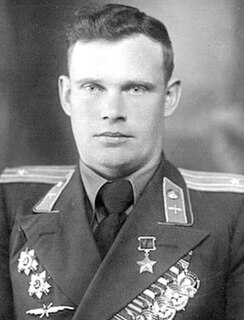
The Mikoyan-Gurevich MiG-15 is a jet fighter aircraft developed by Mikoyan-Gurevich for the Soviet Union. The MiG-15 was one of the first successful jet fighters to incorporate swept wings to achieve high transonic speeds. In combat over Korea, it outclassed straight-winged jet day fighters, which were largely relegated to ground-attack roles, and was quickly countered by the similar American swept-wing North American F-86 Sabre.

"MiG Alley" was the name given by United Nations (UN) pilots during the Korean War to the northwestern portion of North Korea, where the Yalu River empties into the Yellow Sea. It was the site of numerous dogfights between UN fighter pilots and their opponents from North Korea and the People's Republic of China. Soviet-built Mikoyan-Gurevich MiG-15 were the aircraft used during most of the conflict, and the area's nickname was derived from them. It was the site of the first large-scale jet-vs-jet air battles, with the North American F-86 Sabre.

The attack on the Sui-ho Dam was the collective name for a series of mass air attacks during the Korean War on thirteen hydroelectric generating facilities by United Nations Command air forces as part of the North Korean bombing campaign on June 23–24 and June 26–27, 1952. Primarily targeting the hydroelectric complex associated with the Sui-ho Dam in North Korea, the attacks were intended to apply political pressure at the stalled truce negotiations at Panmunjeom.

Nikolai Vasilyevich Sutyagin was a Soviet fighter pilot in the Second World War and the Korean War. He is considered by most Russian sources to be the top ace of the Korean War, with 22 victories.

Yevgeny Georgievich Pepelyaev a Soviet fighter pilot in the Korean war; most Russian sources credit him as the second-highest scoring pilot in the war with 19 shootdowns, placing him only below Nikolai Sutyagin. However, some Western sources indicate him to be the top ace of the war, and he claimed to have 23 victories in his memoir, which would put him above Sutyagin's 22 shootdowns.

Alexander Pavlovich Smorchkov was a Soviet fighter pilot. After gaining three shootdowns during World War II he went on to attain ace status in the Korean War, being credited with 12-13 solo victories on the MiG-15 for which he was awarded the title Hero of the Soviet Union.

Semyon Alekseyevich Fedorets was a MiG-15 pilot of the Soviet Union. He was a flying ace during the Korean war, with 7 victories.

Lev Kirillovich Shchukin was a Soviet MiG-15 flying ace during early phase of the Korean War. After being badly injured from bailing out of his stricken plane he continued to serve as an officer in the Soviet Air Force and was sent to various communist countries as a military adviser.

Dmitry Pavlovich Oskin was a Soviet MiG-15 pilot and flying ace during the Korean war credited with 11 to 19 solo victories.

Mikhail Sergeyevich Ponomaryov was a Soviet fighter pilot who flew with the Polish Air Force during World War II and later became a flying ace during the Korean war, with 10 to 14 victories.

Grigory Ulyanovich Okhay was a Soviet MiG-15 flying ace during the Korean war, with an estimated 11 victories.

Grigory Ivanovich Ges was a Soviet Air Force major who became a flying ace during the Korean War.

Stepan Antonovich Bakhayev was a Soviet Air Force major, flying ace and Hero of the Soviet Union. During World War II, Bakhayev reportedly shot down 13 German aircraft. He also flew during the Korean War and was credited with shooting down 11 American planes, although many of the aircraft he was credited with shooting down were able to return to base after sustaining the damage he inflicted.
The 64th Fighter Aviation Corps was an aviation corps of the Soviet Air Forces. The corps was the parent unit for Soviet interceptor units based in northeastern Manchuria during the Korean War.
The 180th Guards Fighter Aviation Regiment was a military unit of the Red Army Air Force, which took part in the fighting of the Great Patriotic War, and then became part of the Russian Air Defence Forces and finally the Russian Air Force.
The 726th Fighter Aviation Regiment was an aviation regiment of the Soviet Air Forces and the Soviet Air Defense Forces.
The 177th Fighter Aviation Regiment PVO was a fighter regiment of the Soviet Air Defense Forces during World War II and the Cold War, later becoming part of the Russian Air Defense Forces and finally the Russian Air Force.
The 176th Fighter Aviation Regiment PVO was a fighter regiment of the Soviet Air Defense Forces during World War II and the Cold War. The unit was disbanded in March 1960.
The 162nd Fighter Aviation Regiment was a fighter regiment (IAP) of the Soviet Air Force during World War II that became part of the Soviet Air Defense Force (PVO) during the Cold War as the 162nd Fighter Aviation Regiment PVO. It was disbanded in 1959 during the reorganization of the PVO.















